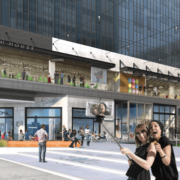IN recent years, more residential buildings, retail centers and restaurants have sprung up in downtown Los Angeles, an area that has mostly been regarded as a place to work and has lacked a bustling after-hours culture.
However, these days, drive around and new developments have injected more life into the area. LA Live, Fig and 7th with a City Target and more high-end retail shops and restaurant row on 7th are some notable examples. The Arts District has drawn in upscale restaurants and a nightlife culture. Nearly block after block is undergoing some sort of construction. There’s even a Whole Foods slated to open in November on the ground floor of the 8th and Grand residential project in the Financial District.
Call it downtown’s renaissance, if you will. Soon it won’t be seen as just a 9-5, weekday center, but rather one that operates on a 24/7 basis like its metropolis counterparts in other areas of the country.
This shift was the topic of discussion at the Asian Business Association of Los Angeles’ first real estate forum on Thursday, July 30, where professionals familiar with the developments spoke on a panel about what to expect in the coming months.
A second-quarter report from the Downtown Center Business Improvement District (DCBID) revealed that over 10,000 residential units are now under construction, with the average apartment rent amounting to $2,475.
In the past 15 years, around $21 billion has been invested into downtown — $9 billion for commercial use, while $7.3 billion was put toward residential projects, AssetAvenue Vice President of Real Estate Rishi Thakkar shared.
The breakdown of the investments (which also includes billions in transit and arts and entertainment) shows an effort to make downtown a “24/7, millennial, transporation-rich” part of LA, Thakkar added.
“We’ve seen a significant reduction of crime, [particularly] violent crime and that perception has contributed to people wanting to be in downtown,” said Ryan Spruston, senior associate and project manager at architecture firm Gensler. “Another notion is that downtown is a more active place. There are a lot more people on the streets day and night and it has made a difference in how people perceive the city…As more people are working and living there, we get a picture of a much more complete city.”
Creative companies are now setting up working spaces in downtown, a traditionally corporate working center, Spurston also pointed out. With abundant residential options, more affluent, educated individuals are considering it as a place to live. A DCBID survey in 2013 found that the median age of downtown residents was 34 years old; median income was $96,700; and 76 percent of respondents earned a four-year undergraduate or graduate degree.
Another trend in the downtown development is that in addition to local investors, foreign sources have also contributed.
Linda Lau, president of Global Law Group, shared how 600 foreign investors poured $11 million into the Oceanwide Plaza (a high-ride condominium, hotel and retail project next to Staples Center) through the EB-5 visa program. Under EB-5, immigrant investors are able to obtain a green card if they invest at least $500,000 and create at least 10 jobs for US workers.
About 90 percent of the EB-5 quota has been used by Chinese investors, given the demand of projects in areas like Southern California. The program caps the number of visas 10,000 annually.
To date, 18 Pacific Rim-based companies have set up offices in downtown LA, according to Arty Maharjh, vice president of DTZ.
“We used to look at downtown as two office nodes, Bunker Hill and Financial District, but it’s become very broad-based now. What we consider downtown [to hold] office, live, work and play has expanded to Chinatown, Arts District, Little Tokyo, and the Fashion District,” Maharjh said.
Wayne Ratkovich, president and CEO of Ratkovich Company, which specializes in developing urban influx and rehabilitation projects, delivered the keynote speech at the forum.
“It seems to me we are witnessing the development of a city, not just with the construction of office buildings,” he said. “The market has been turned loose, the opportunity for the 15 years stretching from 2000 to 2015 is one in building a true city.”
The company’s latest project is to transform the former Macy’s Plaza in downtown into The BLOC, a Metro accessible, pedestrian-friendly retail center. The $180 million renovation — featuring 496 upgraded rooms at the Sheraton Hotel, a renovated Macy’s, more retail shops and restaurants and a 33-story office tower with rooftop garden lounge — is expected to be completed this fall. The property was purchased by the company and its partners in 2013 for $240 million.
“We expect to make The BLOC one of significant contributors to downtown,” Ratkovich said. “[It has] the makings of a very profitable project.”






